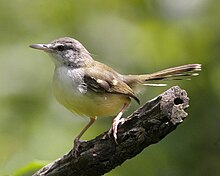Bar-winged prinia
| Bar-winged prinia | |
|---|---|

| |
| Scientific classification | |
| Domain: | Eukaryota |
| Kingdom: | Animalia |
| Phylum: | Chordata |
| Class: | Aves |
| Order: | Passeriformes |
| Family: | Cisticolidae |
| Genus: | Prinia |
| Species: | P. familiaris
|
| Binomial name | |
| Prinia familiaris Horsfield, 1821
| |
The bar-winged prinia (Prinia familiaris) is a species of bird in the cisticola family Cisticolidae. The species is sometimes known as the bar-winged wren-warbler.
Description
The bar-winged prinia is a distinctive prinia, 13 cm long and weighing 8-10 g.[2] The plumage is white grading to yellow below with a grey cap and brown back and wings and a distinctive white double wingbar. The rump is yellow and the tail brown, with orange legs. Both sexes are alike and the juveniles resemble the adults. The song is a loud and repetitive high pitched chweet-chweet-chweet.
Distribution and habitat
It is endemic to Indonesia, where it occurs on the islands of Sumatra (where it occurs on the east of the island), Java and Bali.[2] It occupies a wide range of habitats, from mangrove forest at sea level to montane forest, and is tolerant of human modified environments such as gardens, parks and plantations. The presence of humans within its range is common and its willingness to adapt to the subsequent modified landscapes means it is not threatened with extinction.[2]
In Indonesia this bird is called burung murai, or prenjak (in Javanese), or cici (in Betawi).
Behaviour
The bar-winged prinia feeds on insects.[2] It forages by gleaning from leaves and other surfaces, and it will forage from the ground to the tops of trees. During the non-breeding season it occurs in groups with others of its species, but when breeding it is territorial (although the breeding season is poorly defined, mostly occurring in March to June in Java but some breeding occurring throughout the year. The species constructs an oblong domed nest suspended with spiderweb to branches, usually placed low to the ground. Not much is known about its breeding biology, but it does have a clutch size of two to four eggs.
References
- ^ BirdLife International (2018). "Prinia familiaris". IUCN Red List of Threatened Species. 2018. Retrieved 17 December 2018.
{{cite journal}}: Invalid|ref=harv(help) - ^ a b c d Ryan, Peter (2006). Family Cisticolidae (Cisticolas and allies). Pp. 433-434 in del Hoyo J., Elliott A. & Christie D.A. (2006) Handbook of the Birds of the World. Volume 11. Old World Flycatchers to Old World Warblers Lynx Edicions, Barcelona ISBN 978-84-96553-06-4

